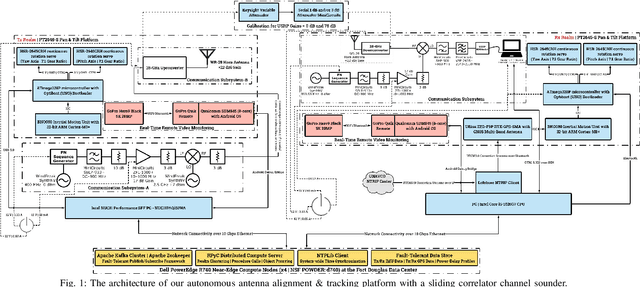Yaguang Zhang
Simulation-Enhanced Data Augmentation for Machine Learning Pathloss Prediction
Feb 06, 2024Abstract:Machine learning (ML) offers a promising solution to pathloss prediction. However, its effectiveness can be degraded by the limited availability of data. To alleviate these challenges, this paper introduces a novel simulation-enhanced data augmentation method for ML pathloss prediction. Our method integrates synthetic data generated from a cellular coverage simulator and independently collected real-world datasets. These datasets were collected through an extensive measurement campaign in different environments, including farms, hilly terrains, and residential areas. This comprehensive data collection provides vital ground truth for model training. A set of channel features was engineered, including geographical attributes derived from LiDAR datasets. These features were then used to train our prediction model, incorporating the highly efficient and robust gradient boosting ML algorithm, CatBoost. The integration of synthetic data, as demonstrated in our study, significantly improves the generalizability of the model in different environments, achieving a remarkable improvement of approximately 12dB in terms of mean absolute error for the best-case scenario. Moreover, our analysis reveals that even a small fraction of measurements added to the simulation training set, with proper data balance, can significantly enhance the model's performance.
Propagation Measurements and Analyses at 28 GHz via an Autonomous Beam-Steering Platform
Feb 16, 2023



Abstract:This paper details the design of an autonomous alignment and tracking platform to mechanically steer directional horn antennas in a sliding correlator channel sounder setup for 28 GHz V2X propagation modeling. A pan-and-tilt subsystem facilitates uninhibited rotational mobility along the yaw and pitch axes, driven by open-loop servo units and orchestrated via inertial motion controllers. A geo-positioning subsystem augmented in accuracy by real-time kinematics enables navigation events to be shared between a transmitter and receiver over an Apache Kafka messaging middleware framework with fault tolerance. Herein, our system demonstrates a 3D geo-positioning accuracy of 17 cm, an average principal axes positioning accuracy of 1.1 degrees, and an average tracking response time of 27.8 ms. Crucially, fully autonomous antenna alignment and tracking facilitates continuous series of measurements, a unique yet critical necessity for millimeter wave channel modeling in vehicular networks. The power-delay profiles, collected along routes spanning urban and suburban neighborhoods on the NSF POWDER testbed, are used in pathloss evaluations involving the 3GPP TR38.901 and ITU-R M.2135 standards. Empirically, we demonstrate that these models fail to accurately capture the 28 GHz pathloss behavior in urban foliage and suburban radio environments. In addition to RMS direction-spread analyses for angles-of-arrival via the SAGE algorithm, we perform signal decoherence studies wherein we derive exponential models for the spatial/angular autocorrelation coefficient under distance and alignment effects.
Data-Driven Web-Based Patching Management Tool Using Multi-Sensor Pavement Structure Measurements
Feb 10, 2023Abstract:Automating pavement maintenance suggestions is challenging,especially for actionable recommendations such as patching location,depth and priority.It is common practice among State agencies to manually inspect road segments of interest and decide maintenance requirements based on the pavement condition index (PCI).However,standalone PCI only evaluates the pavement surface condition and coupled with the variability in human perception of pavement distress,limits the accuracy and quality of current pavement maintenance practices.Here,a need for multi-sensor data integrated with standardized pavement distress condition ratings is required.This study explores the possibility of estimating the appropriate pavement patching strategy (i.e.,patching location,depth,and quantity) by integrating pavement structural and surface condition assessment with pavement specific ratings of distress.Especially,it combines pavement structural condition assessment parameter;falling weight deflectometer deflections along with surface condition assessment parameters;international roughness index,and cracking density for a better representation of overall pavement distress condition.Then,a pavement specific threshold-based patching suggestion algorithm is implemented to evaluate the pavement overall distress condition into a priority-based patching suggestion.The novelty in the use of pavement specific thresholds is placed on its data-driven ability to determine threshold values from current road condition measurements using a reliability concept validated by the theoretical pavement condition rating,pavement structural number.A web-based patching manager tool (PMT) was implemented to automate the patching suggestion procedure and visualize the results.Validated with road surface images obtained from three-dimensional laser sensors,PMT could successfully capture localized distresses in existing pavements.
A Robotic Antenna Alignment and Tracking System for Millimeter Wave Propagation Modeling
Oct 14, 2021

Abstract:In this paper, we discuss the design of a sliding-correlator channel sounder for 28 GHz propagation modeling on the NSF POWDER testbed in Salt Lake City, UT. Beam-alignment is mechanically achieved via a fully autonomous robotic antenna tracking platform, designed using commercial off-the-shelf components. Equipped with an Apache Zookeeper/Kafka managed fault-tolerant publish-subscribe framework, we demonstrate tracking response times of 27.8 ms, in addition to superior scalability over state-of-the-art mechanical beam-steering systems. Enhanced with real-time kinematic correction streams, our geo-positioning subsystem achieves a 3D accuracy of 17 cm, while our principal axes positioning subsystem achieves an average accuracy of 1.1 degrees across yaw and pitch movements. Finally, by facilitating remote orchestration (via managed containers), uninhibited rotation (via encapsulation), and real-time positioning visualization (via Dash/MapBox), we exhibit a proven prototype well-suited for V2X measurements.
Challenges and Opportunities of Future Rural Wireless Communications
Aug 11, 2021


Abstract:Broadband access is key to ensuring robust economic development and improving quality of life. Unfortunately, the communication infrastructure deployed in rural areas throughout the world lags behind its urban counterparts due to low population density and economics. This article examines the motivations and challenges of providing broadband access over vast rural regions, with an emphasis on the wireless aspect in view of its irreplaceable role in closing the digital gap. Applications and opportunities for future rural wireless communications are discussed for a variety of areas, including residential welfare, digital agriculture, and transportation. This article also comprehensively investigates current and emerging wireless technologies that could facilitate rural deployment. Although there is no simple solution, there is an urgent need for researchers to work on coverage, cost, and reliability of rural wireless access.
 Add to Chrome
Add to Chrome Add to Firefox
Add to Firefox Add to Edge
Add to Edge